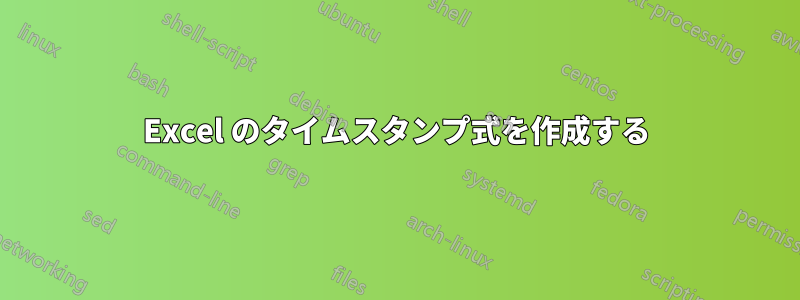
アイデアは単純です。私は、次のような関数を実行して=MOD_DATE_OF(A1:A4)、その範囲内のセルのうちのいずれかが変更されたときに、その数式を割り当てたセルに現在の日付を取得する、という機能が欲しいのです。
ウェブ上でも似たような質問がいくつか見つかりました。ここ、しかし、どれもかなり。
私が入手した中で最も近いのは、どこかにあるこのコードです (申し訳ありませんが、ソースはわかりません)。
Private Sub Worksheet_Change(ByVal Target As Excel.Range)
If Target.Column = 1 Then
Target.Offset(0, 1).Value = Date
End If
End Sub
しかし、それはまだ機能ではありません。
私はOffice 2010のExcelを使用しています
ありがとう
答え1
さまざまな範囲の変更日を監視できる本格的なソリューションをご紹介します。これは、VBA で配列を使用するための Chip Pearson のツールそして機能からスタックオーバーフローユーザー Thomas による回答。
基本的な考え方は、すべての監視対象範囲 (過去または現在) のアドレスが最新の更新日付とともに保存されるグローバル配列によって、関数と Worksheet_Change Sub が相互作用できるようにすることです。Worksheet_Change Sub は、変更された範囲をすべて保存されている範囲と照合して、この配列を更新します。関数は配列内で監視対象範囲を検索し、見つかった場合は保存されている変更日付を返します。見つからない場合は、今日の日付を返します (その後、配列に追加されます)。
また、ブックが閉じられ、タイムスタンプの配列が割り当て解除されたときにタイムスタンプが失われるのを防ぐには、配列を Workbook_Close イベントでシートに書き込み、Workbook_Open イベントで配列に書き直す必要があります。
モジュールに次のコードを貼り付けます。
Public funcInstances() As Variant
Public Function MOD_DATE_OF(monitor As Range)
Application.Volatile True
Dim i As Long
Dim tmpArray() As Variant
If Not IsDimensioned(funcInstances) Then
ReDim funcInstances(1 To 1, 1 To 2) As Variant
funcInstances(1, 1) = monitor.Address
funcInstances(1, 2) = Date
Else
For i = 1 To UBound(funcInstances, 1)
If funcInstances(i, 1) = monitor.Address Then
MOD_DATE_OF = Format(funcInstances(i, 2), "yyyy-mm-dd")
Exit Function
End If
Next i
tmpArray = ExpandArray(funcInstances, 1, 1, "")
Erase funcInstances
funcInstances = tmpArray
funcInstances(UBound(funcInstances, 1), 1) = monitor.Address
funcInstances(UBound(funcInstances, 1), 2) = Date
End If
MOD_DATE_OF = Format(funcInstances(UBound(funcInstances, 1), 2), "yyyy-mm-dd")
End Function
'ExpandArray() is the work of Chip Pearson. Code copied from http://www.cpearson.com/excel/vbaarrays.htm
Function ExpandArray(Arr As Variant, WhichDim As Long, AdditionalElements As Long, _
FillValue As Variant) As Variant
'''''''''''''''''''''''''''''''''''''''''''''''''''''''''''''''''''''''''''''''''
' ExpandArray
' This expands a two-dimensional array in either dimension. It returns the result
' array if successful, or NULL if an error occurred. The original array is never
' changed.
' Parameters:
' --------------------
' Arr is the array to be expanded.
'
' WhichDim is either 1 for additional rows or 2 for
' additional columns.
'
' AdditionalElements is the number of additional rows or columns
' to create.
'
' FillValue is the value to which the new array elements should be
' initialized.
'
' You can nest calls to Expand array to expand both the number of rows and
' columns. E.g.,
'
' C = ExpandArray(ExpandArray(Arr:=A, WhichDim:=1, AdditionalElements:=3, FillValue:="R"), _
' WhichDim:=2, AdditionalElements:=4, FillValue:="C")
' This first adds three rows at the bottom of the array, and then adds four
' columns on the right of the array.
'
'''''''''''''''''''''''''''''''''''''''''''''''''''''''''''''''''''''''''''''''''
Dim Result As Variant
Dim RowNdx As Long
Dim ColNdx As Long
Dim ResultRowNdx As Long
Dim ResultColNdx As Long
Dim NumRows As Long
Dim NumCols As Long
Dim NewUBound As Long
Const ROWS_ As Long = 1
Const COLS_ As Long = 2
''''''''''''''''''''''''''''
' Ensure Arr is an array.
''''''''''''''''''''''''''''
If IsArray(Arr) = False Then
ExpandArray = Null
Exit Function
End If
'''''''''''''''''''''''''''''''''
' Ensure the dimension is 1 or 2.
'''''''''''''''''''''''''''''''''
Select Case WhichDim
Case 1, 2
Case Else
ExpandArray = Null
Exit Function
End Select
''''''''''''''''''''''''''''''''''''
' Ensure AdditionalElements is > 0.
' If AdditionalElements < 0, return NULL.
' If AdditionalElements = 0, return Arr.
''''''''''''''''''''''''''''''''''''
If AdditionalElements < 0 Then
ExpandArray = Null
Exit Function
End If
If AdditionalElements = 0 Then
ExpandArray = Arr
Exit Function
End If
NumRows = UBound(Arr, 1) - LBound(Arr, 1) + 1
NumCols = UBound(Arr, 2) - LBound(Arr, 2) + 1
If WhichDim = ROWS_ Then
'''''''''''''''
' Redim Result.
'''''''''''''''
ReDim Result(LBound(Arr, 1) To UBound(Arr, 1) + AdditionalElements, LBound(Arr, 2) To UBound(Arr, 2))
''''''''''''''''''''''''''''''
' Transfer Arr array to Result
''''''''''''''''''''''''''''''
For RowNdx = LBound(Arr, 1) To UBound(Arr, 1)
For ColNdx = LBound(Arr, 2) To UBound(Arr, 2)
Result(RowNdx, ColNdx) = Arr(RowNdx, ColNdx)
Next ColNdx
Next RowNdx
'''''''''''''''''''''''''''''''
' Fill the rest of the result
' array with FillValue.
'''''''''''''''''''''''''''''''
For RowNdx = UBound(Arr, 1) + 1 To UBound(Result, 1)
For ColNdx = LBound(Arr, 2) To UBound(Arr, 2)
Result(RowNdx, ColNdx) = FillValue
Next ColNdx
Next RowNdx
Else
'''''''''''''''
' Redim Result.
'''''''''''''''
ReDim Result(LBound(Arr, 1) To UBound(Arr, 1), UBound(Arr, 2) + AdditionalElements)
''''''''''''''''''''''''''''''
' Transfer Arr array to Result
''''''''''''''''''''''''''''''
For RowNdx = LBound(Arr, 1) To UBound(Arr, 1)
For ColNdx = LBound(Arr, 2) To UBound(Arr, 2)
Result(RowNdx, ColNdx) = Arr(RowNdx, ColNdx)
Next ColNdx
Next RowNdx
'''''''''''''''''''''''''''''''
' Fill the rest of the result
' array with FillValue.
'''''''''''''''''''''''''''''''
For RowNdx = LBound(Arr, 1) To UBound(Arr, 1)
For ColNdx = UBound(Arr, 2) + 1 To UBound(Result, 2)
Result(RowNdx, ColNdx) = FillValue
Next ColNdx
Next RowNdx
End If
''''''''''''''''''''
' Return the result.
''''''''''''''''''''
ExpandArray = Result
End Function
'IsDimensioned() is the work of StackOverflow user @Thomas. Code copied from https://stackoverflow.com/a/5480690/657668
Public Function IsDimensioned(vValue As Variant) As Boolean
On Error Resume Next
If Not IsArray(vValue) Then Exit Function
Dim i As Integer
i = UBound(vValue)
IsDimensioned = Err.Number = 0
End Function
適切なワークシート モジュールに次のコードを貼り付けます。
Private Sub Worksheet_Change(ByVal Target As Range)
Application.EnableEvents = False
Dim j As Long
If IsDimensioned(funcInstances) Then
For j = 1 To UBound(funcInstances, 1)
If Not Intersect(Target, Range(funcInstances(j, 1))) Is Nothing Then
funcInstances(j, 2) = Date
End If
Next j
Me.Calculate
End If
Application.EnableEvents = True
End Sub
最後に、ThisWorkbook モジュールに次のコードを貼り付けます。
Private Sub Workbook_BeforeClose(Cancel As Boolean)
If IsDimensioned(funcInstances) Then
Application.ScreenUpdating = False
'Store array on a new temporary and hidden worksheet.
Dim tmpS As Worksheet, tmpR As Range
Set tmpS = Worksheets.Add
tmpS.Name = "TEMP Record of Timestamps"
tmpS.Visible = xlSheetHidden
Set tmpR = tmpS.Range("A1:B1").Resize(UBound(funcInstances, 1), 2)
tmpR.Value = funcInstances
ThisWorkbook.Save
Application.ScreenUpdating = True
End If
End Sub
Private Sub Workbook_Open()
Dim ws As Worksheet, tstamps As Range
Dim wsfound As Boolean
wsfound = False
Application.ScreenUpdating = False
For Each ws In ThisWorkbook.Worksheets
If ws.Name = "TEMP Record of Timestamps" Then
wsfound = True
Exit For
End If
Next ws
If wsfound Then
Set tstamps = ws.UsedRange
funcInstances = tstamps.Value
Application.DisplayAlerts = False
ws.Delete
Application.DisplayAlerts = True
End If
Application.ScreenUpdating = True
End Sub
このページを偶然見つけた人への注意:コメントの多くは以前の不完全な解決策に関するものなので、混乱しないでください。


